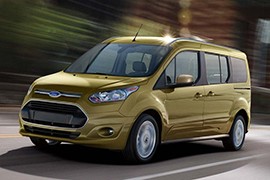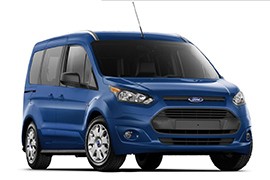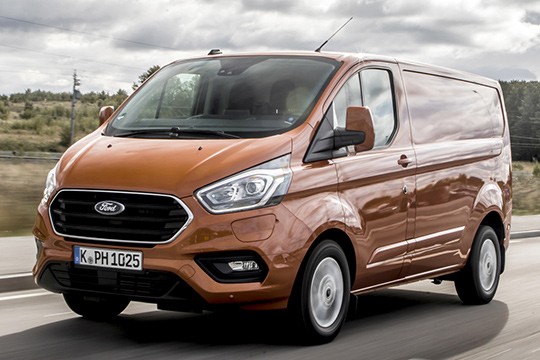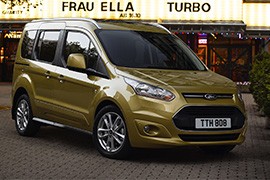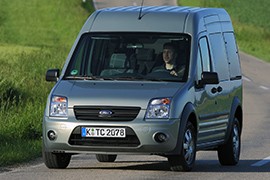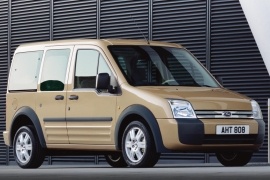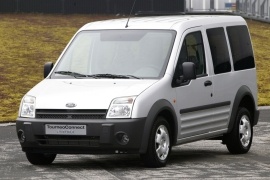FORD Tourneo Models/Series Timeline, Specifications & Photos
First production year: 2003
Engines: Diesel, Gasoline
Body style: Van
The need for a car that can be used as a people carrier and a utility vehicle was proven over the time and, in 2018, Ford launched the Transit Connect with 7 seats at the Chicago Auto Show.
The Transit Connect Wagon started its life as a utility vehicle. It was adapted for family use or a team of workers in the same vehicle with their tools and, why not, a ladder strapped on the roof. For others, it was their family vehicle with a surfboard on top.
Short front, two available lengths, and up to seven seats inside. These were, for short, the most important features of the 2018 Ford Transit Connect Wagon. The large MPV was also available with a long wheelbase and up to 7 seats. If the middle and the rear seats were folded or removed, a very big platform was formed and transformed it into a camper-van.
It offered interesting features for its class, especially for the safety systems, such as the Automatic Emergency Braking that included the Pre-Collision Assist with Pedestrian Detection. The technology offered by Ford in that MPV was also noticeable in the infotainment unit with the Sync3 system that featured a 6.5" touch-screen.
To move the vehicle, Ford installed two engine options: a 1.5-liter turbodiesel or a 2.0-liter gasoline unit. Both were mated to a standard 8-speed automatic transmission built for economy.
The need for a car that can be used as a people carrier and a utility vehicle was proven over the time and, in 2018, Ford launched the Transit Connect with 5 seats at the Chicago Auto Show.
The Transit Connect Wagon started its life as a utility vehicle. It was adapted for family use or a team of workers in the same vehicle with their tools and, why not, a ladder strapped on the roof. For others, it was their family vehicle with a surfboard on top.
Short front, two available lengths, and up to seven seats inside. These were, for short, the most important features of the 2018 Ford Transit Connect Wagon. The large MPV was also available with a long wheelbase and up to 7 seats. The standard (or short) wheelbase had room for 5 passengers and a big trunk, which could be extended by folding down the rear seats.
It offered interesting features for its class, especially for the safety systems, such as the Automatic Emergency Braking that included the Pre-Collision Assist with Pedestrian Detection. The technology offered by Ford in that MPV was also noticeable in the infotainment unit with the Sync3 system that featured a 6.5" touch-screen.
To move the vehicle, Ford installed two engine options: a 1.5-liter turbodiesel or a 2.0-liter gasoline unit. Both were mated to a standard 8-speed automatic transmission built for economy.
Ford refreshed the Turneo Custom in 2017, improving the vehicle's look and cabin, despite being just a civilized version of a van.
While in the U.S., most entrepreneurs who are working in construction and maintenance are going for pickup trucks, in Europe, these kinds of self-employed people turned their attention towards vans. Ford knew that when it made the first generation of the Transit in 1965. Over time, it also realized that this model needed to expand in so many different sizes and shapes that it had to create other lines of products, like spin-offs from the primary model. So, enter the scene the Transit Custom's first generation in 2012. Come 2017, this compact-sized MPV got a facelift to cope better with customers' demands. Nevertheless, that upgrade was required by new European emission standards for LCVs. But the Transit Custom was also offered as a people carrier.
From the outside, the Turneo Custom (passenger version of the Transit Custom) featured a revised front fascia with integrated LEDs for the daytime running lights into the headlamps. In addition, the main grille was smoothened and adorned with a chromed trim. An unusual styling element was on the lower bumper, which featured a pair of side scoops for fog lamps and a center-mounted apron with a lip spoiler. From its sides, there were no significant changes, although, at the back, the vertical taillights that flanked the tailgate sported an angular design.
Inside, depending on the configuration and options, the MPV could get up to nine people. Inside the instrument cluster, Ford installed a display instead of analog dials and gauges. In addition, atop the center stack, the automaker placed a touchscreen for the infotainment system.
As expected for European vans, the Turneo Custom was powered by turbo-diesel engines. It was, in fact, the same 2.0-liter TDCi tuned to provide different power levels that ranged between 105 and 170 PS (104 -168 hp).
Ford took a Turneo Van, cut some doors and windows on it, and transformed it into a more practical minivan more spacious than most of the MPVs in its segment.
Designed for both sides of the Atlantic, the Turneo Connect shared its platform with the Focus but with a different rear suspension. Its cousin was the Transit Connect, a smaller version of the Ford Transit utility van, which was also available as a people carrier.
With the second generation, Ford tried to eliminate the utility-van look and reshaped the front of the vehicle. Its swept-back headlights resembled those installed on the Fiesta, while the hexagonal grille resembled other Fords (Mondeo, Focus, or Fiesta). The two wide sliding doors were handy on their sides when filling the vehicle with people. At the back, a flat, up-hinged tailgate was the last element that resembled a utility vehicle.
Inside, the carmaker installed a car-like interior with a dashboard designed for regular Joe and Jane, who needed something to understand from their regular cars. The instrument panel sported four dials and an LCD on the upper side, between the speedometer and tachometer. Depending on the trim level and options, Ford offered a SYNC infotainment system developed with Microsoft. The Turneo Connect offered seating for five with a folding and removable rear bench. It provided 913 liters (32.2 cu-ft) of space with all the seats in place, while with them folded, the trunk reached 2,410 liters (85.1 cu-ft).
Under the hood, Ford installed its 1.0-liter EcoBoost engine as its entry-level version, with an option for a 1.6-liter turbocharged gasoline unit. For oil-burners, it provided a 1.6-liter TDCI unit, available in three power options.
Ford introduced the Turneo Connect in 2003 as part of its expansion on the MPV lineup, a model which was refreshed in 2007 and 2009.
Following the successful Transit lineup, Ford changed its marketing strategy and tried to make the LCV division a separate brand. Volkswagen did the same and succeeded with its commercial vehicle division. The Connect was the passenger version for the Turneo, which was a compact light commercial vehicle. Its platform was the same used for the front-wheel-drive Transit.
The headlights at the front resembled those installed on the fifth generation Fiesta, with a large, trapezoidal grille. The car-like bumper comprised two round fog-lights. From its sides, the tall passenger area was accessible via two regular doors at the front and two sliding ones for the rear bench. In the back, the Turneo Connect was available either with a liftgate or with two unequally sized, regular doors.
Inside, the dashboard was similar to the one found on the Fiesta V, with round air-vents and the same instrument cluster. Thanks to its high roof, the interior designers were able to install high-mounted seats at the front and a folding bench in the back. Thus, the car could have been transformed from passenger to cargo vehicle in a matter of seconds.
Unlike Volkswagen, who designed specific engines for the LCV division, Ford chose most of the Turneo Connect ones from the passenger car lineup. It was available with a choice of diesel engines paired as standard with a 5-speed manual gearbox.
In 2007, Ford introduced a facelifted version of the 2003 Turneo Connect, and it was offered as a light utility vehicle or as an MPV.
Ford developed the Turneo as a sub-model for the Transit range, but it took various components from the passenger vehicles lineup. The result was a car that was able to be used as an MPV for a family at the weekend or as a light-utility for a small business over the week.
The facelift brought a new bumper design along with restyled headlights, which incorporated the fog lights. The grille received an enhanced design, with chromed slats for the upper trim levels. There was a choice for light-alloy wheels that visually transformed the LCV look into an MPV look. Unfortunately, the door-mirrors and the handles were available only as black, unpainted elements.
Inside, Ford worked to enhance the ride quality. While the lower trim levels featured only cranked windows, the upper trim levels featured air-conditioning, CD-player, power-windows, and locks. The second row of seats was tilting and removable, so the car could have been used as an MPV or an LCV.
Under the hood, Ford installed the new generation of the TDCI engines, which featured the common-rail technology. The gasoline units were no longer on the list due to their low demand.
Ford introduced the Turneo Connect in 2003 as part of its expansion on the MPV lineup, a model good for families and small enterprises as well.
Following the successful Transit lineup, Ford changed its marketing strategy and tried to make the LCV division a separate brand. Volkswagen did the same and succeeded with its commercial vehicle division. The Connect was the passenger version for the Turneo, which was a compact light commercial vehicle. Its platform was the same used for the front-wheel-drive Transit.
At the front, the headlights resembled those installed on the fifth generation Fiesta and the European Fusion, with a large, trapezoidal grille. The car-like bumper comprised two round fog-lights and an additional A-shaped grille on the lower side. Its tall passenger area was accessible via two regular doors at the front and two sliding ones for the rear bench. In the back, the Turneo Connect was available either with a liftgate or with two, side-hinged doors.
Inside, the dashboard was similar to the one found on the Fiesta V, with round air-vents and the same instrument cluster. Thanks to its high roof, the interior designers were able to install high-mounted seats at the front and a folding bench in the back. Thus, the car could have been transformed from passenger to cargo vehicle in a matter of seconds.
Unlike Volkswagen, who designed specific engines for the LCV division, Ford chose most of the Turneo Connect ones from the passenger car lineup. It was available with a choice of diesel engines ranged between 75 hp and 110 hp, paired as standard with a 5-speed manual gearbox.
